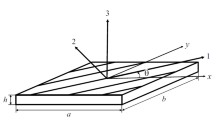Abstract
The buckling loads of eight-ply AS4/3501-6 graphite/epoxy cylindrical panels with delaminations were determined experimentally. The delaminations fabricated into the laminate with Mylar and Teflon inserts, represent the effect of low-velocity projectile impact damage. The Mylar was found to cause partial delamination while the Teflon inserts caused total delamination. Two types of insert positions were considered; eccentric or off-midsurface, and midsurface. The eccentric delaminations were placed progressively through the thickness of the laminate. STAGSC-1 finite-element computer code results for undelaminated composite panels were compared to the experimental results to obtain a percent strength degradation.
The experimental testing was accomplished by the Air Force Flight Dynamics Laboratory. The test device provided boundary conditions of clamped top and bottom edges and simply supported vertical sides.
Two destructive techniques, stereo X-ray and deply, were used to determine the total delaminated areas and locations. Based in part on these results, one equivalent delamination was obtained corresponding to the total area of the multiple partial delaminations. The panels with multiple delaminations were found to be approximately five-percent weaker than a single delaminated area of the same total size.
Similar content being viewed by others
References
Sendeckyi, G., Maddux, E. and Porter, E., “Damage Documentation in Composites by Stereo Radiography,” ASTM STP 775, 16–26 (1982).
Freeman, S., “Damage Progression in Graphite-Epoxy by Deplying Technique,” Air Force Wright Aero. Lab. Tech. Rep., AFWAL-TR-81-3157 (Dec. 1981).
Seifert, G. andPalazotto, A., “The Effect of a Centrally Located Midplane Delamination on the Instability of Composite Panels,”Experimental Mechanics,26 (4),330–336 (Dec.1986).
Horban, B. andPalazotto, A., “Experimental Buckling of Cylindrical Composite Panels with Eccentrically Located Circular Delaminations,”AIAA J. Spacecraft and Rockets,24 (4),349–352 (July–Aug.1987).
Hebert, J., “Analytical/Experimental Linear Bifurcation of Curved Cylindrical Composite Panels,” MS Thesis, AFIT/GAE/AA/83D-14, Air Force Inst. of Tech., Wright-Patterson AFB, OH (Dec. 1983).
Horban, B., “The Effects of Through the Thickness Delaminations on Curved Composite Panels,”MS Thesis, AFIT/GAE/AA/85D-8, Air Force Inst. of Tech., Wright-Patterson AFB, OH (Dec.1985).
Author information
Authors and Affiliations
Rights and permissions
About this article
Cite this article
Palazotto, A., Maddux, G.E. & Horban, B. The use of stereo X-ray and deply techniques for evaluating instability of composite cylindrical panels with delaminations. Experimental Mechanics 29, 144–151 (1989). https://doi.org/10.1007/BF02321367
Received:
Revised:
Issue Date:
DOI: https://doi.org/10.1007/BF02321367




